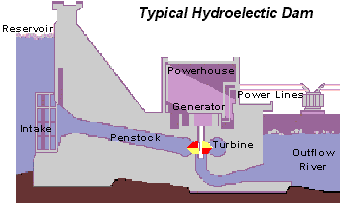 |
|---|
Hydro Power




Shiroro Hydroelectric Power Station
The Shiroro Power Station is a hydroelectric power plant off the Kaduna River in Shiroro, Niger State, Nigeria. It has a power generating capacity of 600 MW enough to power over 404,000 homes The Shiroro Power Station began operation in 1990. NSP holds the concession for the Shiroro Hydroelectric Power station. NSP has been operating the 600 MW station since 2013, and is expected to do so for 30 years - the length of the concession agreement with the Bureu of Public Enterprise.
How Hydropower Plants Work
So just how do we get electricity from water? Actually, hydroelectric and coal-fired power plants produce electricity in a similar way. In both cases a power source is used to turn a propeller-like piece called a turbine, which then turns a metal shaft in an electric generator, which is the motor that produces electricity. A coal-fired power plant uses steam to turn the turbine blades; whereas a hydroelectric plant uses falling water to turn the turbine. The results are the same. The theory is to build a dam on a large river that has a large drop in elevation (As we speak, there are two dams in Niger state - Shiroro and Kanji dams). The dam stores lots of water behind it in the reservoir.


Near the bottom of the dam wall there is the water intake. Gravity causes it to fall through the penstock inside the dam. At the end of the penstock there is a turbine propeller, which is turned by the moving water. The shaft from the turbine goes up into the generator, which produces the power. Power lines are connected to the generator that carry electricity to your home and mine. The water continues past the propeller through the tailrace into the river past the dam. A hydraulic turbine converts the energy of flowing water into mechanical energy. A hydroelectric generator converts this mechanical energy into electricity. The operation of a generator is based on the principles discovered by Faraday.
Near the bottom of the dam wall there is the water intake. Gravity causes it to fall through the penstock inside the dam. At the end of the penstock there is a turbine propeller, which is turned by the moving water. The shaft from the turbine goes up into the generator, which produces the power. Power lines are connected to the generator that carry electricity to your home and mine.
The water continues past the propeller through the tailrace into the river past the dam. A hydraulic turbine converts the energy of flowing water into mechanical energy. A hydroelectric generator converts this mechanical energy into electricity. The operation of a generator is based on the principles discovered by Faraday.

